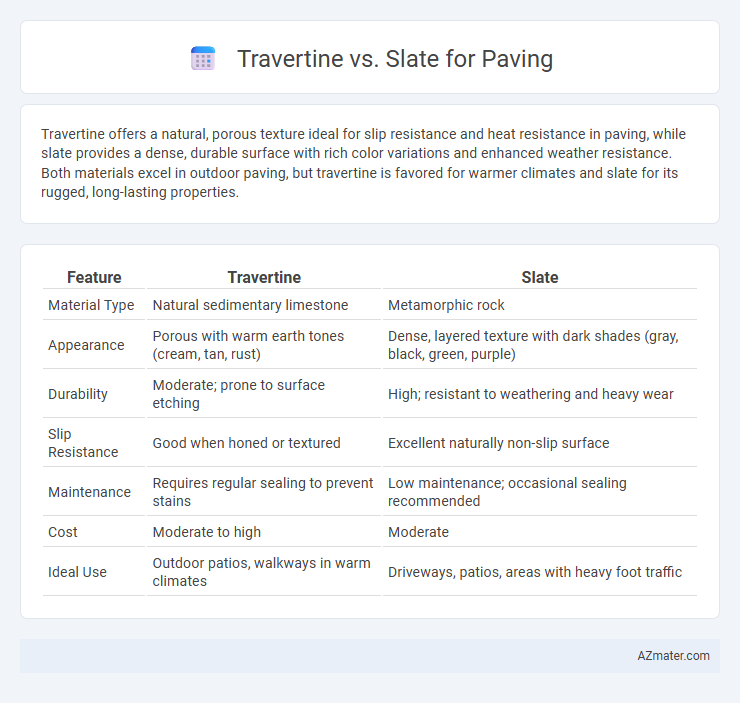Travertine offers a natural, porous texture ideal for slip resistance and heat resistance in paving, while slate provides a dense, durable surface with rich color variations and enhanced weather resistance. Both materials excel in outdoor paving, but travertine is favored for warmer climates and slate for its rugged, long-lasting properties.
Table of Comparison
| Feature | Travertine | Slate |
|---|---|---|
| Material Type | Natural sedimentary limestone | Metamorphic rock |
| Appearance | Porous with warm earth tones (cream, tan, rust) | Dense, layered texture with dark shades (gray, black, green, purple) |
| Durability | Moderate; prone to surface etching | High; resistant to weathering and heavy wear |
| Slip Resistance | Good when honed or textured | Excellent naturally non-slip surface |
| Maintenance | Requires regular sealing to prevent stains | Low maintenance; occasional sealing recommended |
| Cost | Moderate to high | Moderate |
| Ideal Use | Outdoor patios, walkways in warm climates | Driveways, patios, areas with heavy foot traffic |
Introduction to Travertine and Slate
Travertine, a natural limestone formed by mineral deposits from springs, is prized for its porous texture and warm beige tones, making it ideal for elegant and slip-resistant paving. Slate, a metamorphic rock known for its dense, fine-grained structure and rich dark hues, offers outstanding durability and a non-slip surface suitable for outdoor paving in harsh weather conditions. Both materials provide unique aesthetic and functional benefits, with travertine favoring a classic Mediterranean appeal and slate ensuring robust performance and natural rustic charm.
Key Differences Between Travertine and Slate
Travertine features a porous, natural stone texture with light, earthy tones, making it ideal for warm climates and slip-resistant surfaces, while slate offers a dense, fine-grained structure with dark, rich colors and superior durability in harsh weather conditions. Travertine's smoother surface warms quickly underfoot, contrasting with slate's cooler touch and higher resistance to scratches and stains. Maintenance demands differ as travertine requires sealing due to its porosity, whereas slate is more resilient but can be more prone to chipping.
Aesthetic Appeal: Colors and Textures
Travertine paving offers warm, earthy tones ranging from ivory and tan to rust, with a naturally porous texture that provides a classic, sophisticated look. Slate paving features darker shades such as charcoal, blue-gray, and green, boasting a fine-grained, layered texture that adds a modern, rugged elegance. The choice between travertine's smooth, honed finishes and slate's cleft, textured surfaces significantly affects outdoor aesthetic appeal and design cohesion.
Durability and Longevity
Travertine offers impressive durability for paving, with a natural resistance to cracking and weathering, ensuring longevity in varied climates. Slate stands out for its exceptional hardness and resistance to abrasion, making it highly durable for high-traffic outdoor areas. Both materials provide long-lasting performance, but slate generally offers superior lifespan due to its dense, non-porous structure.
Slip Resistance and Safety
Travertine offers moderate slip resistance due to its naturally porous surface, making it suitable for dry and mildly wet conditions, while slate generally provides higher slip resistance thanks to its textured, cleft surface, enhancing safety in wetter environments. Slate's durability and rougher texture reduce the risk of slips and falls, making it a preferred choice for areas prone to moisture or heavy foot traffic. Both materials are durable, but slate edges out travertine in slip resistance, contributing to a safer paving surface overall.
Maintenance Requirements
Travertine paving requires regular sealing to prevent staining and maintain its natural appearance, with periodic cleaning using mild detergents to avoid surface damage. Slate paving demands low maintenance but benefits from occasional sealing to enhance durability and resist moisture infiltration. Both materials should be swept regularly to remove debris, but slate's higher density often results in better resistance to cracking and weathering compared to travertine.
Climate Suitability and Weather Resistance
Travertine offers excellent climate suitability for warm and humid regions due to its porous nature, providing natural slip resistance and cool surface temperatures ideal for outdoor paving. Slate, with its dense, non-porous composition, excels in colder climates by resisting frost damage and preventing water absorption that can cause cracking. Both materials provide durable weather resistance, but travertine's ability to remain cooler under direct sunlight makes it preferable for hot climates, whereas slate's robust strength suits areas with significant freeze-thaw cycles.
Installation Process Comparison
Travertine paving requires careful cutting and sealing due to its porous nature, demanding precise installation techniques to prevent staining and water absorption. Slate offers easier installation with its natural cleft surface providing better slip resistance and minimal sealing requirements, making it suitable for outdoor paving. Both materials benefit from professional laying on a level base with joint filling to ensure durability and stability.
Cost: Upfront and Long-Term
Travertine paving typically costs between $15 to $30 per square foot upfront, offering a durable and attractive surface that can last 25 years or more with proper maintenance. Slate paving ranges from $10 to $25 per square foot initially, but its denser composition often means less frequent repairs, potentially reducing long-term expenses. Considering both materials, travertine's higher upfront cost may be offset by its longevity, while slate provides a cost-effective option with moderate durability for paving projects.
Which is Best for Your Paving Project?
Travertine offers a natural, warm aesthetic with excellent slip resistance and durability, making it ideal for pool decks and patios in warmer climates. Slate provides a dense, textured surface with superior resistance to staining and extreme weather, suitable for high-traffic areas and outdoor environments prone to moisture. Selecting the best paving material depends on your project's location, climate, and desired maintenance level, with travertine excelling in softness and warmth while slate excels in toughness and weather resistance.

Infographic: Travertine vs Slate for Paving
 azmater.com
azmater.com